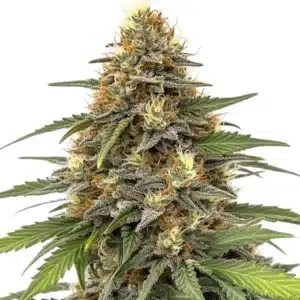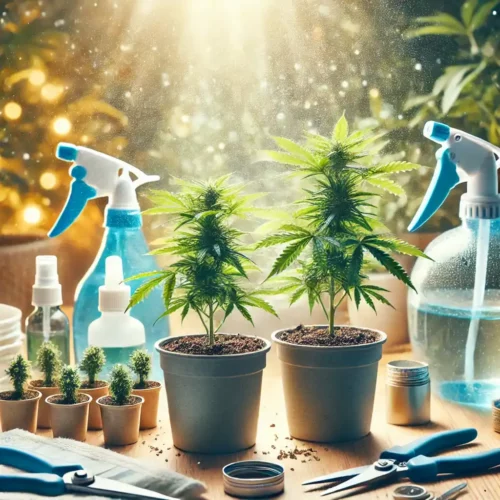Cannabis bud rot, also referred to as “Big Bud Disease,” “The Curse of the Successful Grower,” or weed molding, is a menacing threat to your prized buds just as they near harvest time.
The onset of bud rot can be merciless, targeting your largest and most robust buds with lethal consequences. Typically, the first indication of cannabis bud rot is the sudden wilting or yellowing of leaves on a significant bud, often occurring within a mere 1–2-day timeframe. Upon closer inspection, the base of these afflicted leaves reveals the insidious presence of rot. Mold is frequently visible, serving as a grim confirmation of the devastation caused by bud rot.
The insidious nature of weed molding is essential for safeguarding your harvest and maximizing yield. Stay vigilant, identify symptoms early, and implement effective prevention and treatment strategies to mitigate the risk of cannabis bud rot wreaking havoc on your crop.
What is bud rot on cannabis plants?
Gray mold, also referred to as bud rot, represents a fungal infection thriving in cool, humid climates. It poses a threat to marijuana plants at any developmental stage. Originating from the fungus Botrytis cinerea, bud rot can deteriorate buds internally, hence earning its moniker “gray mold.” This process of weed molding is especially destructive because it often starts deep inside the buds, making it difficult to detect until significant damage has occurred.
Aside from marijuana, Botrytis has the potential to damage various other plants such as wine grapes, strawberries, and peonies. Bud rot, propelled by its dusty gray mold spores, can infiltrate your plants at any given time.
Actual contact with these gray mold spores is imperative for bud rot to occur. Unfortunately, these spores are easily transportable. Upon reaching your cultivation site, they infiltrate your plants through wounds or tears in the external plant tissue. Training your plants might result in stem cracks that facilitate mold transmission. Furthermore, any damage inflicted by pests like caterpillars, snails, worms, or mildew can serve as conduits for bud rot infiltration into your plants.
Promos & Deals
How to prevent mold weed?
To prevent bud rot and mold in cannabis plants, it’s crucial to avoid wet buds and high humidity. Bud rot, a fungal infection, thrives in moist environments. Aim for 40-50% relative humidity during the flowering stage to deter bud rot. Humidity levels exceeding 60% pose significant risks, particularly for dense buds. Promptly address damp or excessively humid conditions. Indoor cultivators can utilize powerful dehumidifiers, while outdoor growers should shield plants from rain and shake off excess moisture. Opting for short-flowering or auto-flowering strains can also mitigate risks associated with rainy seasons.
Optimal air circulation is paramount to prevent weed molding and protect your plants from humidity-related issues. Ensure airflow over buds and leaves by employing fans indoors and using strategic positioning outdoors. Exhaust fans can effectively vent hot, humid air away from plants, reducing the risk of mold. Oscillating fans aid in dispersing air but may not lower overall humidity levels. Defoliating dense plants can also help minimize humidity by reducing water vapor emitted from leaves, particularly in confined spaces. Focus on removing shaded or lower leaves that contribute minimally to photosynthesis.
Vigilance is key in monitoring long, dense buds for discoloration, a potential sign of bud rot. Timely removal of affected buds and nearby ones is imperative to prevent the spread of this fungus. As bud rot typically targets larger colas, swift action is necessary to salvage the crop. Consider harvesting prematurely if environmental conditions conducive to bud rot persist beyond control, minimizing further losses.

Signs indicating the presence of rot in cannabis plant buds
Bud rot penetrates the youngest stems near the soil, causing them to brown, soften, and decay— a process known as “damping off.” Mature plants aren’t spared either, as gray mold attacks their stems, forming a brownish-gray mycelium mass, stifling the plant’s growth and causing it to yellow due to chlorophyll deficiency.
This insidious rot can weaken stems with cankers, leading to wilting and breakage. But its devastation doesn’t stop there. After ravaging stems, bud rot targets moist buds on female marijuana plants. Leaves brown and wilt, followed by pistils, culminating in buds covered in gray mycelium, rendering them useless at harvest.
This affliction may affect the largest buds or manifest as spots across the plant, darkening and drying up colas. Despite the outward appearance of health, the wettest spots on plants remain vulnerable to weed molding. Prevention is key, especially for plants with large colas, which are prime targets due to limited air exposure and high moisture.
Detecting bud rot typically involves spotting deadened areas or white mold on buds. However, by the time symptoms are visible, the damage is often extensive. Look for dark gray or brown dusty interiors of affected buds, signaling advanced stages of bud rot. Gray mold, initially powdery white, transitions to brown or smoky gray hues as it progresses.
Growers in low-light environments are particularly susceptible to bud rot. If unsure about your plant’s health, refer to resources on marijuana diseases for identification and management tips. Vigilance and preventive measures are essential to safeguard your plants against this relentless threat.
Mold on Indoor Growing
The significance of preventing gray mold from infecting your cannabis plants is crucial. For indoor growers, implementing specific measures can mitigate the risk effectively. It’s imperative to maintain a warm, dry, and well-ventilated environment for your plants. Ensure the grow room temperature remains above 70 degrees Fahrenheit and avoid excessive humidity, keeping it below 50%. While these factors are uncontrollable outdoors, indoor growers can manage them effectively.
Reducing leaf density is another strategy to enhance air circulation and minimize the likelihood of gray mold formation. However, it’s essential to strike a balance, ensuring sufficient leaves remain to facilitate light absorption during flowering and harvesting phases. Prioritize the removal of leaves covering others or impeding bud growth for optimal results.
Preventing Bud Mold in Outdoor Marijuana Plants
As an outdoor marijuana grower, selecting the right strain for your climate is crucial. If you reside in a rainy, cool area, opt for strains tailored to such conditions to reduce the risk of weed molding. Consider strains with shorter lifespans or those that automatically enter the flowering phase. Timing your harvest is key to maximizing yield. Download our free mini harvesting guide for expert tips.
Extra precautions include changing clothes before entering your grow area to limit spores and pests. Keep pets away as they may carry harmful fungi. Sanitize pruning shears to prevent the spread of bacteria. These measures apply equally to outdoor grow spaces.
Water your plants during the day to allow ample drying time before nightfall. Adequate ventilation is essential to reduce moisture, a breeding ground for Gray Mold. Be diligent in monitoring your plants for signs of disease.
For added prevention, consider spraying with bacillus subtilis or oils like neem or sesame. Potassium Bicarbonate can also inhibit mold and fungi growth organically. If bud rot occurs, promptly remove and destroy affected plants. Avoid composting diseased plants. Alternatively, prune affected parts and disinfect tools thoroughly. Bordeaux mixture or copper spray can help control bud rot.
Maintain vigilance by regularly inspecting plants, especially during the flowering phase. Monitor weather patterns for potential risk periods, such as after rain or cooler temperatures. Cover plants with a tarp before rain, ensuring it’s suspended above to prevent damage. After rain, shake plants to dislodge water droplets and deter mold growth.

What are the factors behind the occurrence of Bud Rot?
In cannabis cultivation, Botrytis cinerea initiates bud deterioration from within, leading to the infamous “bud rot” phenomenon. This process is one of the most common forms of weed molding, where infected buds exhibit a moldy, dark gray, or brown interior upon inspection. The symptoms of bud rot may vary across different plants.
The fungus is commonly known by several names including “botrytis bunch rot,” “botrytis blight,” “grey mold,” or simply “Bud Rot” in the context of cannabis cultivation, reflecting the primary concern of growers.
Any segment of the cannabis plant affected by bud rot should be promptly removed to prevent further contamination. It’s crucial to avoid smoking or using buds touched by this harmful fungus. Botrytis progresses through different stages, starting as fluffy white or brown mold before infiltrating susceptible buds internally, causing them to darken. Mature stages involve the release of spores, manifesting as dark speckled dust, which can spread easily upon contact.
Fortunately, healthy cannabis plants are less likely to develop bud rot unless exposed to stagnant air and prolonged wet conditions or high humidity. Temperature fluctuations, particularly extreme heat or cold, can heighten susceptibility to bud rot, fungus, or mold. Maintaining an optimal temperature of around 75°F (24°C) during the late flowering stage can mitigate these risks while promoting the production of high-quality buds.
How mold appears on cannabis plants
Bud rot, or weed molding, can devastate cannabis crops if not managed effectively. The spread of this fungus is facilitated by dusty gray spores, typically carried by wind or water. Shielding your plants from these spores is crucial to safeguarding against bud rot. Regrettably, these spores can infiltrate your plants through various means, including breeze, rainfall, animal contact, or even via clones from other grow rooms. Even indoor environments aren’t immune, as dormant spores may linger in the air, awaiting favorable conditions to strike.
Rather than solely focusing on shielding buds from spores, it’s far more effective to preemptively prevent the conditions conducive to bud rot. Once buds are infected, they can release millions of spores, necessitating immediate and careful removal from the vicinity of your plants. Maintaining optimal environmental conditions for buds is paramount to deterring fungus germination. Additionally, any form of damage or weakness in the plant, such as stem cracks from wind, damage from pests, or other injuries, can serve as entry points for bud rot spores.
Bud rot thrives in wet or humid environments, making it essential to create a moderate, dry, and breezy atmosphere for your cannabis plants, especially indoors where control is more manageable. By prioritizing prevention and environmental control, you can significantly reduce the risk of bud rot and protect your valuable cannabis harvests.
Which is better to combat mold. Neem Oil, Burning Sulfur, Fungicides?
During the flowering stage, it’s crucial to avoid certain practices to prevent weed molding and bud rot effectively. Using fungicides or spraying affected buds, even with Neem oil, can worsen the situation, affecting taste, smell, and appearance. While some growers resort to fungicides tailored for Botrytis during the vegetative stage, it’s important to note that fungicides should be applied preventatively before bud formation. Once weed molding or bud rot sets in, remedial action becomes challenging.
If bud rot occurs and environmental adjustments fail to resolve the issue, the best course of action is to remove the affected plant. Most fungicides are ineffective against bud rot, emphasizing the importance of prevention.
For those considering fungicidal treatment, opt for products specifically formulated to combat Botrytis. Applying treatments during the vegetative stage serves as a proactive measure against bud rot. Unfortunately, once bud rot manifests, there are no effective fungicides or treatments safe for use during the flowering stage.

South Africa Strain
Originating from a robust lineage intertwining African genetics with Princess 88, the South African strain boasts a rich heritage and an aromatic profile that enthralls enthusiasts. Perfect for expanding gardening ventures, this strain’s distinctive qualities and cultivation needs set it apart. Harnessing the power of selective breeding, South African embodies resilience in growth and a flavor profile that’s truly unique.
Prepare for an exhilarating journey with South African. Its aroma blends earthy tones with subtle sweet and spicy notes, offering a complex sensory experience. The flavor mirrors its diverse genetic background, creating a tapestry of tastes that captivates the palate. With its unique genetic makeup and intricate aromatic profile, South African caters to both recreational and medicinal users, offering a myriad of effects and benefits. Growers should also remain vigilant against common issues like weed molding, especially in humid environments, to preserve the quality and potency of this exceptional strain.
Energize and Uplift: South African provides an energizing and uplifting effect, ideal for daytime use to boost creativity and productivity.
Relieve Stress and Anxiety: This strain offers effective relief from stress and anxiety, promoting a calming yet invigorating experience for users.
Manage Pain: South African pain-relieving properties make it beneficial for individuals dealing with chronic pain, arthritis, and muscle spasms.
Enhance Social Situations: Its uplifting effects make it perfect for socializing, enhancing conversations and overall enjoyment.
Stimulate Appetite: Users may experience a mild increase in appetite, beneficial for medical conditions requiring encouragement to eat.
With its versatile effects and appealing properties, South African caters to a wide range of users, offering a refreshing and enjoyable cannabis experience. Whether seeking therapeutic relief or a unique recreational indulgence, appreciating the potential of this hybrid allows for a deeper recognition of its distinct qualities.
Mexican Haze Strain
Are you on the lookout for a sativa strain that embodies the essence of old-school charm while delivering contemporary performance? Mexican Haze fits the bill perfectly. Whether you’re a seasoned cultivator or just starting out, this strain offers an enticing combination of classic flavor and modern potency that’s sure to impress.
What sets Mexican Haze apart is its ability to thrive in various growing environments. Whether you prefer the open air of outdoor cultivation, the controlled conditions of a greenhouse, or the convenience of indoor setups, Mexican Haze adapts effortlessly, ensuring a bountiful harvest every time.
Picture this: long spears of tightly packed flower clusters, emanating a sweet and tantalizing aroma that hints at the delightful experience to come. Mexican Haze excels in both aesthetics and potency, making it a favorite among growers and consumers alike. But the appeal of Mexican Haze doesn’t stop there. With a relatively short maturation period of 70–80 days, growers can enjoy multiple harvests throughout the year. And with yields averaging between 1.31 – 1.64 oz/ft², it’s no wonder why Mexican Haze is considered a staple in any garden.
So why wait? Experience the magic of Mexican Haze for yourself and elevate your cultivation journey to new heights. Whether you’re a fan of classic sativas or a newcomer to the world of cannabis cultivation, Mexican Haze is sure to exceed your expectations. Unlock the potential of your garden and indulge in the blissful euphoria that only Mexican Haze can provide.
Durban Fast Version Strain
Discover the allure of Durban Poison Fast Version, a sought-after pure South African Sativa strain celebrated among cannabis aficionados. Its feminized nature ensures swift flowering, appealing to cultivators aiming for abundant yields in a shorter timeframe. Crafted from meticulously chosen South African genetics, this strain boasts a pure Sativa lineage renowned for its invigorating effects.
With THC levels ranging from 16% to 23% and a CBD content of approximately 2%, Durban Poison Fast Version offers a balanced and enjoyable high, accompanied by a refreshing citrus aroma reminiscent of zesty lemons and oranges. Indulge in its sweet, tangy flavor profile while relishing its calming and euphoric effects, ideal for daytime use. Expect a flowering time of 8 to 10 weeks, culminating in dense, resinous buds ready for harvest, promising impressive yields both indoors (1.47 – 2.14 oz/ft²) and outdoors (24 – 31 oz/plant). Experience mental clarity, creativity, and focus with Durban Poison Fast Version the epitome of premium cannabis cultivation.
FAQs
What is cannabis bud rot, and how can I identify it?
Cannabis bud rot, also known as “Big Bud Disease” or gray mold, is a fungal infection caused by Botrytis cinerea. It typically attacks large, dense buds and starts with sudden wilting or yellowing of leaves near affected areas. Upon inspection, you may notice brown or gray mycelium inside the buds, often accompanied by a musty smell.
How can I prevent mold and bud rot on my cannabis plants?
To prevent bud rot, maintain optimal airflow and humidity levels (40-50% during flowering) in your grow space. Indoor growers should use fans and dehumidifiers, while outdoor growers should protect plants from rain and excessive moisture. Defoliation of dense foliage and timely watering (preferably in the morning) are also essential to reduce mold risks.
What should I do if I find mold on my cannabis buds?
If you discover mold or bud rot, immediately remove and destroy the affected buds to prevent the fungus from spreading. Disinfect your tools after each use and avoid composting infected material. In severe cases, consider harvesting early if conditions remain too humid for recovery.
















